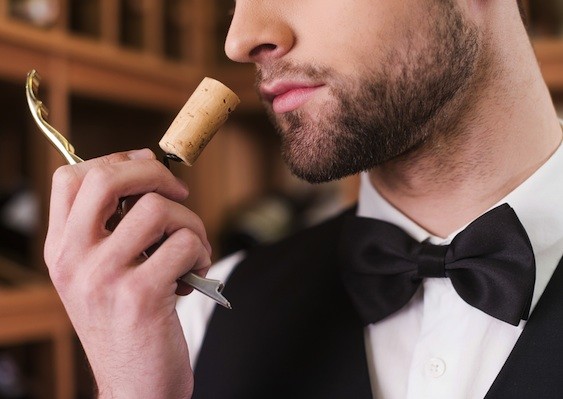You’re on a date. In a restaurant. A nice restaurant. You’re aiming to impress.
You’ve pored over the wine menu…remarking cleverly on the homonyms pore and pour, of course…and finally settled on a bottle for your meal. You order with confidence and the sommelier immediately snaps to attention and fetches your chosen vintage from the glassed-in wine cellar. All nice restaurants seem to have a glassed-in wine cellar these days.

The moment of truth arrives.
She comes back with the bottle and begins the ceremonial presentation of opening it. First cutting away the foil from the lip, then digging her corkscrew in with a few expert twists, she prises out the cork…and places it delicately on the tablecloth next to your hand.
What do you do, hot shot? What do you do?
Keanu can’t help you with this answer. But I can. While some folks seem to think it’s necessary to sniff the cork to detect the faintest whiff of defect in the wine, there’s actually no reason to do so.
Instead, pick up the cork, feel it between your fingers and examine the side that was closest to the liquid in the bottle.

Corks should be moist on the edge that was on the inside of the bottle.
First, you’re looking to make sure the cork is intact and not disintegrating, which could indicate some lapses in transportation and storage. Assuming that’s fine, you are looking for a little color or moisture on the inside edge to let you know that the bottle was stored on its side and the cork was in contact with the wine so that oxygen was unlikely to seep through and ruin it.
Finally, the cork should feel plump and soft, indicating that it has maintained its moisture and shape, protecting the wine in the bottle from premature aging or oxygenation.
Assuming everything looks and feels good with the cork, it is really a sniff and sip of the wine that will tell you if everything is okay in the bottle, far more than smelling a cork will. If in doubt, go right to the source, right?
That said, if you feel like taking a whiff of cork (hey, it does smell good, just like a winery barrel room), go for it. Just don’t do it in a pretentious way.

By all means, sniff the cork, but don’t pretend you’re sophisticated for doing so.
At this point, you’ve navigated the wine order, the wine is delicious, and everything is going well. But if you need one more cork-centric talking point, here it is: corks are wineries’ final guarantee against counterfeits.
By one estimate, over 5% of wines sold at auction (meaning some fine wines and expensive vintages) are counterfeits. One of the ways to guard against this is to examine the corks, which, on authentic wines, are branded with the winery’s label and the vintage of the particular wine along with font and shading that matches. No match, no drink!

